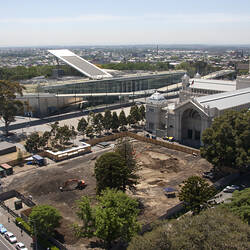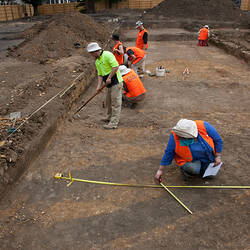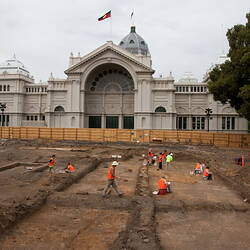The Royal Exhibition Building Western Forecourt Collection consists of 1,566 artefacts excavated during an archaeological dig of the western forecourt of the Royal Exhibition Building, Melbourne, in November 2009. A majority of the artefacts were recovered from nightsoil deposits on the site, which were particularly rich in ceramics, glass and food refuse. Further artefacts were recovered from immediately below the crushed rock base of the circular driveway, which was constructed on the site for the Melbourne International Exhibition, 1880-1881.
The western forecourt was an integral part of the palace garden setting designed by architect Joseph Reed for the Melbourne International Exhibition, 1880-1881. At the opening of the Exhibition the forecourt featured a circular garden of informally planted garden beds and a central kiosk, around which a carriageway led to the western entrance of the building.
The archaeological dig investigated and recorded evidence of the 1880 iteration of the western forecourt garden in order to inform its reconstruction as part of Museum Victoria's World Heritage, World Futures project. The dig also recorded evidence of various incarnations of the site over time, prior to its conversion into an asphalt car park in the 1950s. Heritage consultants Godden Mackay Logan undertook the excavation in conjunction with the archaeology program at La Trobe University.
The artefact collection provides evidence of nightsoil deposited in the Carlton Gardens prior to 1879. Although the source of the nightsoil is as general as 19th century domestic, commercial and/or industrial discard from Melbourne and surrounds, the collection contains many artefacts of historical significance and interest. Artefacts include oyster shells and butchered meat bones, clay pipes, ceramics, wine and beer bottles, building materials including glass panes and wire nails, personal grooming and hygiene items, buttons, ornaments and even a harmonica.
More Information
-
Keywords
archaeological sites, Archaeology, Animal Products, Bones, Bottles, Building Materials, Butchering, Ceramics, Children's Play, Chinaware, Cosmetics, Diet & Nutrition, Domestic Life, Food & Beverages, Food & Drink Consumption, Food Containers, Food Storage & Preservation, Games, Gardening, Glassware, Nails, Porcelain, Pottery, Royal Exhibition Building, Sanitation, Smoking Accessories, Social Life, Tableware, Toilets, Toys, World Heritage
-
Localities
-
Authors
-
Article types




